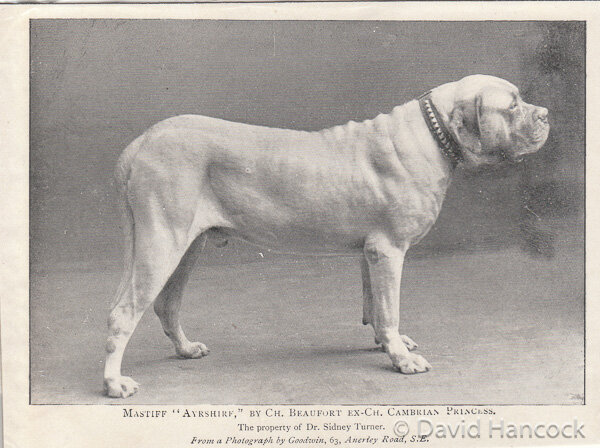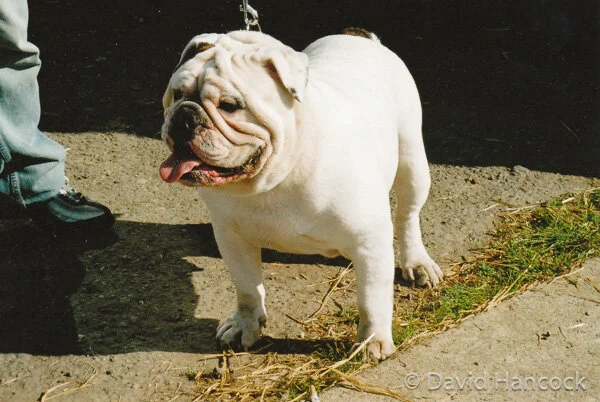1092
AUDITING THE ENGLISH DOG
By David Hancock
How we take for granted the magnificent breeds of English dog handed down to us by our ancestors, pioneer breeders par excellence. If we are to respect the breeds and honour their heritage it is vital to continue all the painstaking dedicated work done selflessly by these admirable people. So often we mention their names in semi-hushed respectful tones only to undo their devoted efforts by disrespectful breeding. Breeders like Colonel Richardson with service-dog Airedales, Laverack in English Setters, Arkwright in Pointers, Brough in Bloodhounds, Cooke in Flatcoats, Dr Sidney Turner in Mastiffs and the Duchess of Newcastle in Fox Terriers, strove mightily to produce outstanding dogs. As did, since them, Mrs McKay in Whippets, Miss Harbutt in Airedales, the Adlams in Bull Terriers, the Tilleys with Old English Sheepdogs and Major Beaumont in Field Spaniels. Each one bred to produce a functional animal. How often nowadays function is relegated or, even worse, overlooked altogether. But how, nowadays, do you assess the 'state of a breed'? Are Breed Councils obliged to submit an annual 'state of the breed' report to the Kennel Club, as would happen in many other walks of life. Shouldn't the supreme body take a close interest in the state our precious national breeds of dog are in?
In the late 19th century, the Kennel Club's own newspaper The Kennel Gazette, regularly published what might be termed annual accounts of the state of a breed at that time. They must have been extremely valuable to breeders and exhibitors and still have value, as many faults seem sealed in a particular breed, like straight stifles in Mastiffs. What made them especially valuable was their honesty, sometimes pulling no punches in their quite painful frankness. But which contributes more to a breed, a thoroughly dishonest critique or a painfully honest one? In contemporary critiques, judges often apologise for being critical - in a critique! Late Victorian judges were far more straightforward, assisting the development of a breed. If any breed has flaws surely it is preferable to confront the challenge rather than wish them away.
The editorial in The Kennel Gazette of January 1889 is a most valuable survey of the breeds being exhibited then. It mentions light eyes, badly-carried sterns and wretchedly-poor bitches in Pointers, laments great size at the expense of type in Clumbers, comments that the golden liver colour in the Sussex Spaniel as becoming almost extinct and complains that Bulldogs of that time 'fail below the eye'. In this issue, a Mastiff judge writes: 'I notice a growing inclination to straight hind legs and general weakness in the hindquarters, which, to my mind, is the greatest possible disfigurement to a mastiff, and will ultimately, if not checked, tend to a sad degeneracy of the breed.' The man was a prophet!
If every Breed Council had to produce an annual audit of their breed, listing the strengths and weaknesses in the breed, would that not contribute to the breed they claim to love? If every show judge was obliged to submit, as the first paragraph of their mandatory critique, a summary of the state of the breed as they found it at that show, would that not contribute to a breed's future? When a breed is degenerating, are we all expected to just watch and keep quiet? Our ancestors thought honesty was the best policy, shaming the contemporary culture of shouting down any and every dissident voice. Read again the reaction of the KC to honestly-intentioned constructive criticism of the dog-game at Crufts time; their whole response is one of denial, never let's look at this, for the good of dogs. That conflicts with their self-imposed mandate of being there principally for 'the general improvement of dogs'.
The Kennel Gazette of February 1889 covered the need in Gordon Setters to 'get back to the real hunting qualities of this breed'. In the same issue a retriever judge, William Arkwright no less, wrote that 'it is quite extraordinary to me how judges can award prizes to so-called retrievers, which are manifestly unfit for their work...' Honesty and tactfulness don't always go together but, when selecting future breeding stock, give me honesty every time. Are we aiming to breed better dogs or striving to avoid hurting people's feelings?
In this same issue, the great Bloodhound breeder, Edwin Brough, wrote: 'I fear that dog shows and their attendant changes of fashion have done an immense amount of harm to some of our most useful breeds'. We need a kennel club, but we need an honest one, a robust one, not one in a state of denial or eternally defensive or one so self-regarding. The work of a kennel club affects canine welfare; it affects the well-being of breeds too. When the discredited Dangerous Dogs Act was being drawn up, the Home Office regarded the Kennel Club as the national organisation concerned with breeds of dog and consulted them as such. But you cannot claim authority without the exercise of responsibility: responsibility for the future of our breeds of dog. You cannot carry out such a task without information and without taking action when this is needed. Without an annual audit breeds can deteriorate and breeders become complacent. New breeders need to know what past stock in their breed was like. Who is to tell them without someone in authority auditing the breed?
What were the English dogs like twenty years, or say ten generations, ago? Have the faults discovered then been bred out? Here are some of the judges' comments from Crufts 1994, as published in the weekly dog papers: Beagles - "I was surprised to find at least 6 hounds had qualified with bad mouths"; Whippets - "How sad that many of them cannot move the way the breed should"; Mastiffs - "The majority of the mastiffs were very disappointing and not in keeping with the breed standard"; Airedale Terriers - "I am sorry to say that the anatomic structure of most...even if they were Champions, was more or less incorrect"; Old English Sheepdogs - "Overall the quality was poor". Entries at Crufts get bred from! Who is breeding out these identified faults? The 1994 Crufts judges were even less impressed by the gundog breeds entry, and remember these are all winning dogs from qualifying shows: Cocker spaniels - "...it was disappointing to find...dogs which were upright in shoulder and had poor movement. This was particularly sad in view of the fact that they had to pass a hurdle before qualifying for Crufts". A year later, the 1995 Crufts judges' criticisms of their breed ran -"Many bitches standing looked a picture but when they moved, oh dear! they fell apart." Most of these dogs get bred from; we are breeding-in faults; we need an auditor! And soon!
The 1994 Airedale Crufts judge made some points for me in the show critique: "I am sorry to say that the anatomic structure of most of the Airedales shown in the ring, even if they were champions, was more or less incorrect...It is only possible to produce a well laid back shoulder...if upper arm and shoulder blade are the same length." Sadly, five years later, the Airedale Crufts judge was to report that "Movement, as always, is not as it should be." Forty years ago, in my book 'The Heritage of the Dog', I wrote of my concern over the front action and incorrectly placed shoulders in this breed. My publisher sent on to me an irate letter from an Airedale breeder to the effect that the breed was fine and didn't need my interference. As a teenaged kennel boy to my local vet, I had the privilege of accompanying him to Molly Harbutt's Airedale kennel at Bathampton. There I saw superlative Airedales of a quality just not seen nowadays. Was I right? Who is auditing this breed?
An American specialist Whippet judge reported, after judging the breed here: "Straight shoulders were practically endemic...Not nearly enough emphasis is placed on the standard's requirement for 'muscular power and strength' combined with 'elegance and grace of outline'..." This judge also stated finding "exaggerated front action and no drive from behind". For this experienced judge to find straight shoulders practically endemic in a large entry of 212 is worrying. The judge at the N Counties Club show of 2001 reported: "Fronts seem to present the most problems", finding a lack of angulation. A recent Whippet Club show report stated that: "Movement on the whole was not good" complaining once again about upright shoulders, resulting in some 'rather odd front movement'. Judges’s comments ten years later included: “Good front movement was the hardest to find…”; “Over-angulation is creeping in very quickly…”; “Movement, on some that I know have won well, was all over the place…”; “…several dogs were just too short-stepping, mainly due to straight front construction and upright shoulders…”; “We seem to be losing toplines and that thrust and drive from behind, also the occasional lifting of the front legs thus losing the daisy-cutting movement…” A decade had passed and the faults appear ingrained.
In a long well-argued and valuable critique, the judge at the Joint Whippet Club’s autumn show in 2011 wrote: “I must honestly say that in my more than 25 years of judging the breed, I have never judged a more variable entry of Whippets than this…the winners were outstanding…but on the other hand I was worried about the number of dogs shown that I would classify as downright poor Whippets…Frankly what a significant number of dogs were lacking was pure and simply type and quality.” This commendably honest judge went on to list as faults: oversized exhibits, massively round bone, enormous heads, woolly coats, thick skin, thick ears, untypical expressions and unbalanced movement. No doubt many of these poor quality Whippets were bred from and this can only be bad news for the breed as a whole. To me, this situation indicates that there are many in this breed, on the show circuit, who just do not know what a quality dog should look like. Who, but an ignorant exhibitor, would show a poor quality dog at all? Why isn't the breed auditing itself? But just as importantly, why isn't the national body, set up to care for our pedigree English breeds auditing the quality or lack of it in their show rings? Come on, Kennel Club, be proactive!













